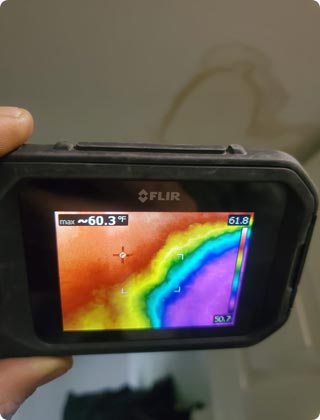
5 Common Signs of Mold in Your Home
Nobody wants to believe that they may have mold growing in their home. Here at O2 Mold Testing, we've found that a lot of people are powerless to detect mold in their own homes without the help of trained mold inspectors, professional equipment, and technically sound inspection methods.
Not only is the idea of having a host of living, breathing fungal invaders creeping throughout the dark recesses of your living space an 'unsavory' idea, but it also poses many complicated problems (not the least of which are health risks).
With that being said, detecting mold in your home without professional help is actually surprisingly difficult. In fact, short of a few obvious signs and symptoms, it may be downright impossible to detect mold in your home without some specialized tools and knowledge in your corner.
So in this blog post, you're going to learn the 5 most common signs and symptoms to look for so that you'll know exactly how to check for mold in your home with as much accuracy as possible. Let's dive into it.
What Are The Common Causes Of Mold?
As a general rule, only two things are required to allow for the growth of mold within your home:
- Moisture
- Organic material
According to cdc.gov, mold can enter your home in a variety of ways. It can enter through open doorways, windows, heating and cooling systems, and vents. It can even track in on shoes, and can be carried in by pets.
Signs Of Mold In Your Home
Understanding how to spot mold within your home is important if you want to be able to take action before its existence negatively impacts your life to a significant degree. Here are the top 5 things to look for.
1. Musty Smell
Mold contains compounds known as microbial volatile organic compounds. These compounds have strong odors, which means that you can usually smell mold if there are enough of these ‘particles' in the air. They smell musty and dirty. Thus, detecting a 'musty' smell in your home could be a sign that mold is present.
2. Strange Stains On Carpets
Because carpets contain small fibers that are easy for fungus growths to stick to, mold will often spread to carpets. This will tend to result in strange stains that could be white, black, green, or sometimes even bluish or reddish in color.
3. Constant Allegy-Like Symptoms
Mold can trigger allergy-like symptoms and immune responses due to the tiny airborne spores that they produce and send flying out into the air you breathe. These can be carried by the HVAC system and find their way into your body when you breathe them in.
4. Warped Walls
Most interior home walls are covered with drywall-which is a porous material. Thus, mold growth on the inside of the wall will tend to warp it on both sides. This can be an indication that mildew and mold growth have infiltrated your walls.
5. Visible Black, Green, Or Pink Stains
Mold growth tends to create stains. These can be black, green, blueish, pink, or even whitish in color-depending on the type of mold you're dealing with. This is basically due to the pigment that's produced by the mold as it grows into the material (wood, carpet, etc.).
Can Mold In Your Home Cause Any Health Problems?
One of the most frequently asked questions we get about mold is this: Can mold cause any health problems?
Unfortunately, the presence of mold in your home can definitely cause health problems. The EPA.gov website describes it like this:
“Molds have the potential to cause health problems. Molds produce allergens (substances that can cause allergic reactions), irritants, and in some cases, potentially toxic substances (mycotoxins). Inhaling or touching mold or mold spores may cause allergic reactions in sensitive individuals. Allergic responses include hay fever-type symptoms, such as sneezing, runny nose, red eyes, and skin rash (dermatitis).”
How To Prevent Mold Growth In Your Home?
The number one key to preventing mold growth in your home is to control the level of moisture. The best way to accomplish this is to keep the humidity levels in your home below 60% on a regular basis. You can do this by fixing leaks and running a dehumidifier to help reduce moisture in the air.
How To Detect Mold In Your Home To Know For Sure?
If you suspect that you may have mold in your house, the only way to find out for certain is to contact a mold inspection service. DIY tests are usually not very reliable, and special equipment will still likely need to be used to tell you with 100% certainty if you're experiencing a mold invasion in your home.
In addition to an inspection, a professional mold testing service can also test air samples. But these procedures, which are some of your best odds for catching mold before it really gets out of control, cannot be carried out without professional help.
Need Help Diagnosing A Mold Problem? Contact Us Today
If you suspect that you may have mold in your home, O2 Mold Testing can help. Our team of certified mold inspection experts has over 20 years of professional experience dealing with unwanted fungal invaders, and we offer a full range of mold testing and inspection services, including:
- Visual inspection
- Moisture testing
- Air sampling
Mold can be a serious health hazard. So if you suspect that you may have mold in your home, contact O2 Mold Testing today to identify the problem and develop a plan to get rid of the mold and get your home back to normal.


